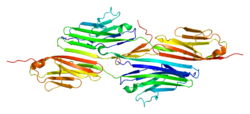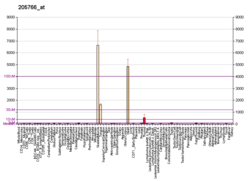Function
Telethonin expression is developmentally regulated in both cardiac and skeletal muscle and is thought to be critical to sarcomere assembly. [11] Telethonin was found to be a late assembling protein only present in mature myofibrils at Z-discs. [12]
Telethonin forms a complex with muscle LIM protein (MLP) at sarcomere Z-discs, which constitutes part of the cardiomyocyte stretch sensory mechanism. [13] It has also been shown that Telethonin binds to the beta-subunit of the slow activating component of the delayed rectifier potassium channel, MinK, in areas localized to T-tubule membranes surrounding Z-lines in the inner myocardium. [14] In addition, Telethonin interacts with the sodium channel Na(v)1.5, and alters the activation kinetics via doubling the window current. [15] These data suggest that Telethonin may constitute a mechano-electrical links between Z-lines and T-tubules. Further functional evidence for this has come from studies utilizing a Telethonin-knockout mouse (KO), which have shown that Telethonin is involved in T-tubule structure and function, as well as apoptosis in the heart. Telethonin KO animals showed preserved Titin anchoring at baseline, and instead showed a profound deficit during nuclear biomechanical stress in modulating the turnover of the proapoptotic p53 protein. [16] Telethonin KO animals also displayed calcium transient dysynchrony, T-tubule loss and depressed L-type calcium channel function. [17]
Telethonin is a substrate of titin kinase, [18] protein kinase D (PKD) and CaM Kinase II. [19] Telethonin, as well as TNNI3, MYBPC3 and MYOM2 are phosphorylated by PKD in cardiomyocytes, and this leads to a reduction in calcium sensitivity of myofilaments, as well as accelerated crossbridge kinetics. [20] Bis-phosphorylation of Telethonin specifically at sites Serine-157 and Serine-161 has been shown to be essential for normal T-tubule organization and intracellular calcium transient kinetics. [19]
The intracellular degradation of Telethonin is regulated by MDM2 in a proteasomal-dependent yet ubiquitin-independent manner. [21] Telethonin specifically interacts with the pro-apoptotic protein Siva, suggesting that Telethonin may be involved in the mechanism underlying Coxsackievirus B3 infection in acute and chronic myocarditis [22]
Telethonin was also identified to be targeted and regulated by transcriptional activators CLOCK and BMAL1, thus demonstrating that TCAP is a circadian regulated gene. [23]
Clinical Significance
Mutations in this gene are associated with limb-girdle muscular dystrophy type R7 (previously 2G), [24] hypertrophic cardiomyopathy, [25] [26] [27] dilated cardiomyopathy, [28] [29] idiopathic cardiomyopathy, [30] and gastrointestinal smooth muscle-related diseases. [15]
Two mutations in Telethonin, Thr137Ile and Arg153His have been associated with hypertrophic cardiomyopathy, which enhance the binding of Telethonin with Titin and MYOZ2. The Glu132Gln mutation has been associated with dilated cardiomyopathy, which has the opposite effect in that it impairs the binding of Telethonin with Titin and MYOZ2. [31] Mutations in Titin associated with dilated cardiomyopathy, including Val54Met, have been shown specifically to impair binding of Titin with Telethonin. [32] In a mouse model of dilated cardiomyopathy, recapitulating the human dilated cardiomyopathy mutation in MLP, Trp4Arg, studies have found that this mutation disrupts normal binding and localization of MLP with Telethonin. [13] In a rat model of hypertension-induced cardiomyopathy, a human variant of BMP10, Thr326Ile, showed decreased binding to Telethonin and increased extracellular secretion. [33]
This page is based on this
Wikipedia article Text is available under the
CC BY-SA 4.0 license; additional terms may apply.
Images, videos and audio are available under their respective licenses.







